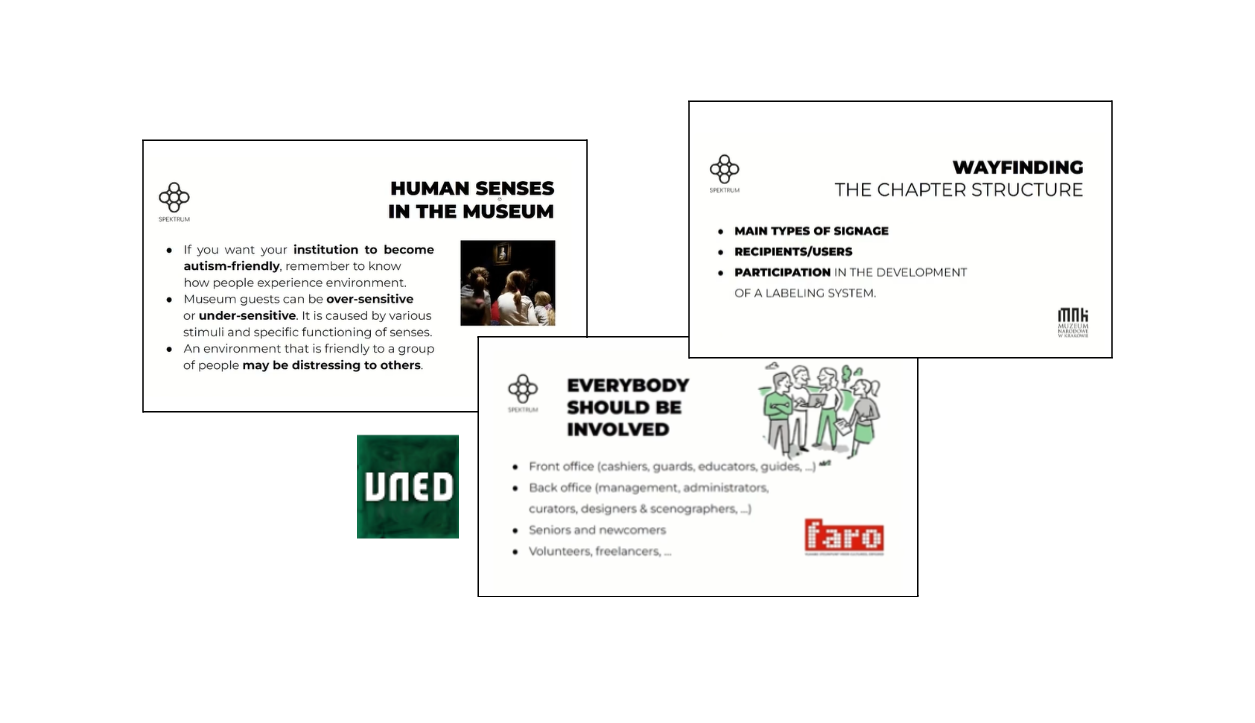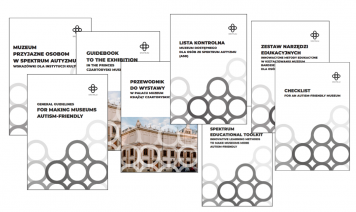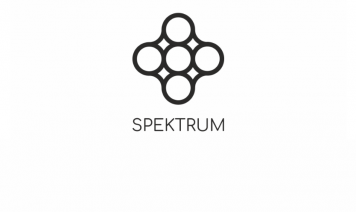Project Spektrum | online course
Open online course, intended for employees of museums, cultural institutions and everyone who would like to make their space more friendly for people with ASD.
We invite you to take advantage of the remote training that we have developed together with our partners. The recordings were prepared as part of the "Spektrum" project during a project meeting in Madrid, in the studio of our partners from UNED.
The information that you will learn here is the result of the joint work of the "Spektrum" team.
Lecturers: Paul Swift, development consultant, OIP Outside In Pathways (United Kingdom), Alexander Vander Stichele, research coordinator, , FARO – Vlaams Steunpunt voor cultureel erfgoed vzw (Belgium), Covadonga Rodrigo, deputy director, Transfer, Research and Innovation of the ETSI Informatica, UNED (Spain), Isabela Stawarz, specialist in education department, MNK Muzeum Narodowe w Krakowie (Poland), Beata Cichy, coordinator for accessibility, MNK Muzeum Narodowe w Krakowie (Poland), Antonella Poce, professor, Uni Roma3 (Italy)
—
Film production: Jaime González Bustos / CEMAV
For any planned action, the starting point is making up a diverse project team with people from the staff as well as people from other parts of the organisation. Make sure your goal to become an autism-friendly museum is fully backed by the senior management of the museum and members of the board. It’s especially important to provide the staff with knowledge about autistic spectrum disorders and what they will be expected to do for visitors with autism.
The first step to develop an autism-friendly museum is to provide clear and adequate information about your institution and the way it wants to be autism-friendly: what is there to see and to do, what adjustments have been made to make it more autism-inclusive, what tools and aids are available for visitors. This information should be easily available (off-line and/or online) for people with autism and their supporters. A predictable, trusted environment and knowing how to ‘use’ the museum can refine future experience of those with higher support needs.
If you want to become an autism-friendly museum, it’s essential to obtain knowledge about the way people with autism sense and experience their environment. They can be hypersensitive or hyposensitive, which means that neutral surroundings will be beneficial for them, with no extremes in senses.
Feeling highly uncomfortable may result in ‘stimming’ – behaviours such as rocking, swinging, hand flapping, repetition of some phrases or shouting. It’s important to be aware of it and make a calm, safe space or even an escape route available if necessary. Consider all of the main senses – where and how you can make adjustments in the museum to minimize the probability of over- and understimulation.
In addition to altering the physical environment, some museums offer services, activities, or aids designed specifically for visitors with autism. Before deciding on what resources you might need, diagnose the problem, do some research and identify the most effective way of providing support.
The people affected by ASD have abnormal responses to incoming sensory information from the surrounding environment. We can provide different tools and methods that stimulate various sensory channels in order to facilitate the subjective response of each person.
The information that you will learn here is the result of the joint work of the "Spektrum" team.
Lecturers: Paul Swift, development consultant, OIP Outside In Pathways (United Kingdom), Alexander Vander Stichele, research coordinator, , FARO – Vlaams Steunpunt voor cultureel erfgoed vzw (Belgium), Covadonga Rodrigo, deputy director, Transfer, Research and Innovation of the ETSI Informatica, UNED (Spain), Isabela Stawarz, specialist in education department, MNK Muzeum Narodowe w Krakowie (Poland), Beata Cichy, coordinator for accessibility, MNK Muzeum Narodowe w Krakowie (Poland), Antonella Poce, professor, Uni Roma3 (Italy)
—
Film production: Jaime González Bustos / CEMAV
SERIES OF MOVIES
Training materials in English and Spanish.
As with every project, you need to write a plan setting out a roadmap of the actions you will make to arrive at your destination of an autism-friendly museum. It will help you understand where you are on your journey and remind everyone about what further steps need to be taken. We do not recommend any particular approach to planning an autism-friendly museum, but you may find the following questions helpful when devising your plan.For any planned action, the starting point is making up a diverse project team with people from the staff as well as people from other parts of the organisation. Make sure your goal to become an autism-friendly museum is fully backed by the senior management of the museum and members of the board. It’s especially important to provide the staff with knowledge about autistic spectrum disorders and what they will be expected to do for visitors with autism.
The first step to develop an autism-friendly museum is to provide clear and adequate information about your institution and the way it wants to be autism-friendly: what is there to see and to do, what adjustments have been made to make it more autism-inclusive, what tools and aids are available for visitors. This information should be easily available (off-line and/or online) for people with autism and their supporters. A predictable, trusted environment and knowing how to ‘use’ the museum can refine future experience of those with higher support needs.
If you want to become an autism-friendly museum, it’s essential to obtain knowledge about the way people with autism sense and experience their environment. They can be hypersensitive or hyposensitive, which means that neutral surroundings will be beneficial for them, with no extremes in senses.
Feeling highly uncomfortable may result in ‘stimming’ – behaviours such as rocking, swinging, hand flapping, repetition of some phrases or shouting. It’s important to be aware of it and make a calm, safe space or even an escape route available if necessary. Consider all of the main senses – where and how you can make adjustments in the museum to minimize the probability of over- and understimulation.
In addition to altering the physical environment, some museums offer services, activities, or aids designed specifically for visitors with autism. Before deciding on what resources you might need, diagnose the problem, do some research and identify the most effective way of providing support.
The people affected by ASD have abnormal responses to incoming sensory information from the surrounding environment. We can provide different tools and methods that stimulate various sensory channels in order to facilitate the subjective response of each person.


